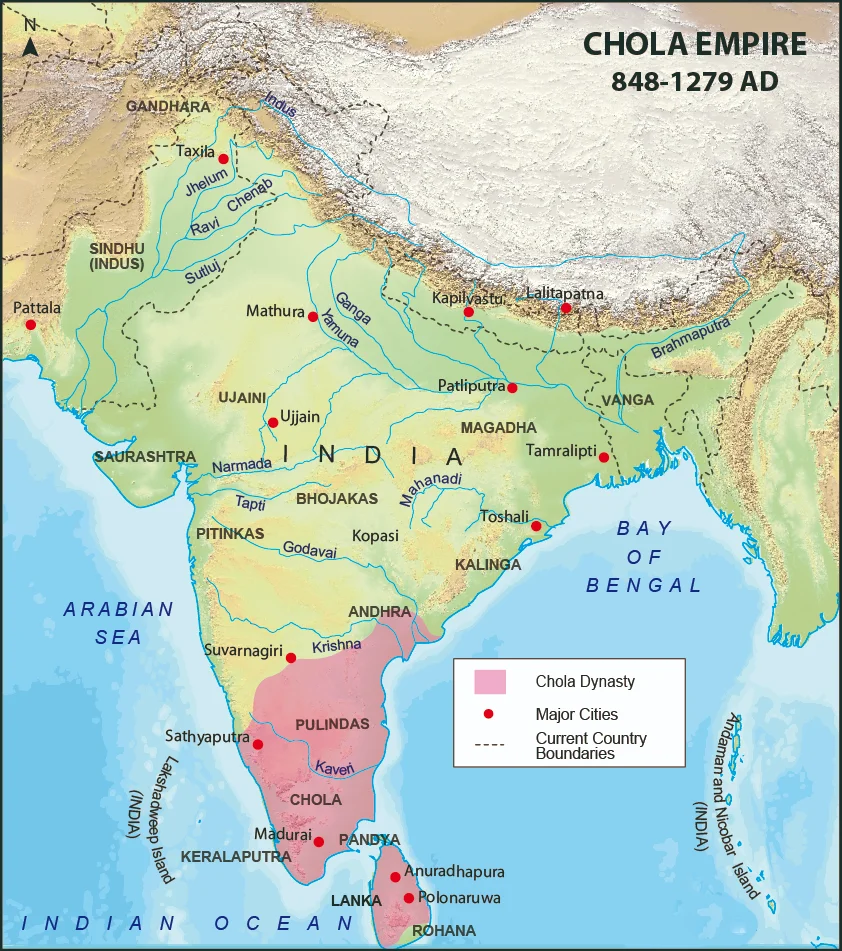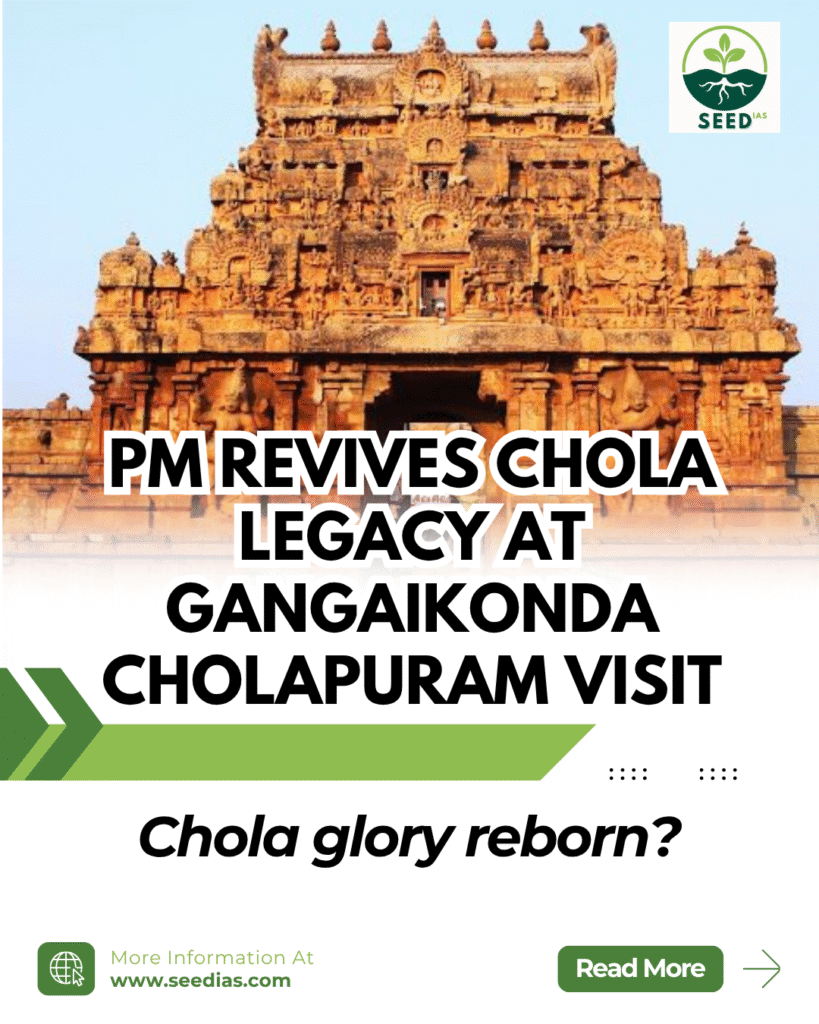Why in NEWS
The Prime Minister visited Gangaikonda Cholapuram (Ariyalur, Tamil Nadu) during the Aadi Thiruvathirai festival and released a commemorative coin marking 1000 years of Rajendra Chola I’s Gangetic expedition, while celebrating the Chola dynasty’s administrative brilliance and maritime power.
Key Terms and Concepts
| Term | Explanation |
|---|---|
| Rajendra Chola I | Son of Rajaraja Chola I; great Chola emperor known for naval expeditions |
| Gangaikonda Cholapuram | Capital built by Rajendra Chola I after northern conquests |
| Aadi Thiruvathirai | Festival honoring Rajendra Chola’s birth star and Chola cultural heritage |
| Gangaikondacholeeswaram | Temple built by Rajendra Chola I in Dravidian style, now UNESCO site |
| Kudavolai System | Palm-leaf ballot system used in village elections during Chola rule |
Key Facts About Rajendra Chola I
| Aspect | Details |
|---|---|
| Period | Ruled from 1014 to 1044 AD |
| Titles | Gangaikonda Cholan, Kadaram Kondan, Pandita Cholan, Mudikondan |
| Military Feats | Defeated Palas, Chalukyas; conquered Sri Lanka, Maldives, Southeast Asia |
| Capital | Established Gangaikonda Cholapuram as new capital |
| Naval Power | Led India’s earliest recorded overseas expeditions |
| Cultural Patron | Supported Shaivism; tolerant of Vaishnavism and Buddhism |
| Trade | Tamil merchant guilds (Manigramam, Ayyavole) flourished; strong ties with China, SEA |
Chola Dynasty Overview
| Feature | Details |
|---|---|
| Founded | By Vijayalaya Chola in 9th century AD |
| Peak | Under Rajaraja Chola I and Rajendra Chola I |
| Territories | South India, Sri Lanka, Southeast Asia |
| Decline | With Pandya resurgence in the 13th century |
| Notable Rulers | Vijayalaya, Rajaraja I, Rajendra I, Kulottunga I, Rajaraja II |

Key Features of Chola Administration & Architecture
| Area | Features |
|---|---|
| Governance | Centralized monarchy; local self-governance via Sabhas and Urs |
| Village Democracy | Kudavolai ballot system for elections; eligibility rules ensured merit and accountability |
| Revenue | Land revenue (1/6th of produce), profession tax, salt, marriage dues, tolls (abolished by Kulottunga I) |
| Military | Four divisions – infantry, cavalry, elephants, navy; elite forces like Velaikkarar and Kaikkolaperumpadai |
| Trade | Merchant guilds like Nanadesis; ports like Puhar; maritime trade with West Asia, China, SEA |
| Art & Architecture | Dravidian temple style; Vimana towers; bronze sculptures (e.g. Nataraja), wall paintings |
| Major Temples | Brihadisvara (Thanjavur), Gangaikondacholeeswaram (Ariyalur), Airavatesvara (Darasuram) |
Gangaikonda Cholapuram Temple Highlights
| Feature | Description |
|---|---|
| Built by | Rajendra Chola I to mark victory over the Gangetic plains |
| Style | Refined Dravidian architecture |
| Significance | Symbol of military power and Shaiva devotion |
| Inscriptions | 1027 AD, 1068 AD; Esalam copper plates (1036 AD) |
| Cultural Events | Aadi Thiruvathirai celebrates Rajendra’s birth star with Therukoothu performances |
| UNESCO Status | Included in “Great Living Chola Temples” (2004), along with Thanjavur and Darasuram |

In a Nutshell
Memory Code: “RAJENDRA VISION”
- Rajendra’s conquests
- Aadi festival tribute
- Jewels of Dravidian architecture
- Empire across seas
- Naval legacy
- Democratic Kudavolai
- Refined bronze art
- Administrative excellence
- Village autonomy
- International trade
- Shaivism and tolerance
- Nationwide heritage recognition
Prelims Questions
- Consider the following statements about Rajendra Chola I:
- He built the Brihadisvara Temple in Thanjavur.
- He established Gangaikonda Cholapuram as the new capital.
- He led India’s first overseas naval expeditions.
Which of the above is/are correct?
A) 2 and 3 only
B) 1 and 2 only
C) 1 and 3 only
D) 1, 2 and 3
- The Kudavolai system practiced under the Cholas was related to:
A) Land revenue assessment
B) Military recruitment
C) Temple construction
D) Local village elections - Which temple was built to commemorate Rajendra Chola I’s northern expeditions?
A) Airavatesvara Temple
B) Brihadisvara Temple, Thanjavur
C) Gangaikondacholeeswaram
D) Kampaharesvara Temple
Mains Questions
- Examine the administrative structure and democratic practices of the Chola Empire with special reference to the Kudavolai system. 10 Marks (GS1 – History)
- Discuss the significance of Rajendra Chola I’s maritime expeditions in shaping early Indian overseas influence. 10 Marks (GS1 – Culture & Indian Heritage)
Answers and Explanations (Prelims)
| Ques | Answer | Explanation |
|---|---|---|
| 1 | A | Statement 1 is incorrect—Brihadisvara was built by Rajaraja I, not Rajendra I |
| 2 | D | Kudavolai was a palm-leaf ballot system for village self-governance elections |
| 3 | C | Gangaikondacholeeswaram was built by Rajendra I after his Gangetic conquest |
















